As an Amazon Associate KitchenwareSets.com earns from qualifying purchases.
9 Expert Sage Green Kitchen Wall Color Pairing Rules
Struggling to find a kitchen color that feels both fresh and timeless? You’re not alone in wanting a change that will last.
Sage green kitchen walls offer a calming, earthy backdrop. But the biggest challenge is making this sophisticated neutral work with your existing cabinets and countertops without clashing.
Sage green kitchen walls are a timeless choice because their desaturated, earthy tone provides a sophisticated neutral backdrop that is both calming and versatile. This guide will give you 9 expert rules to coordinate sage green perfectly, creating a kitchen you’ll love for years.
Are Sage Green Kitchen Walls Still Timeless in 2025?
Yes, absolutely. Sage green has successfully transitioned from a fleeting trend to a foundational design classic. The reason for its longevity lies in its unique characteristics. Unlike brighter, more saturated colors, sage green is a desaturated, grayish-green. This low chroma value positions it as a sophisticated neutral, much like beige or light gray, but with more personality.
Its staying power is also rooted in biophilic design principles—the concept of connecting our living spaces with nature. According to industry literature, incorporating natural colors like desaturated greens can reduce stress and create a tranquil atmosphere. This makes sage green an excellent choice for a busy space like the kitchen. It provides a calming, organic backdrop that won’t feel dated in 2025 or beyond.
9 Expert Sage Green Kitchen Wall Color Pairing Rules
To ensure your sage green kitchen looks professionally designed, follow these nine expert rules. These guidelines are based on core interior design principles, including color theory and the critical 60-30-10 rule, to help you coordinate your walls with cabinets, trim, and hardware flawlessly.
1. Master the Warm White Rule for All Trim and Ceilings
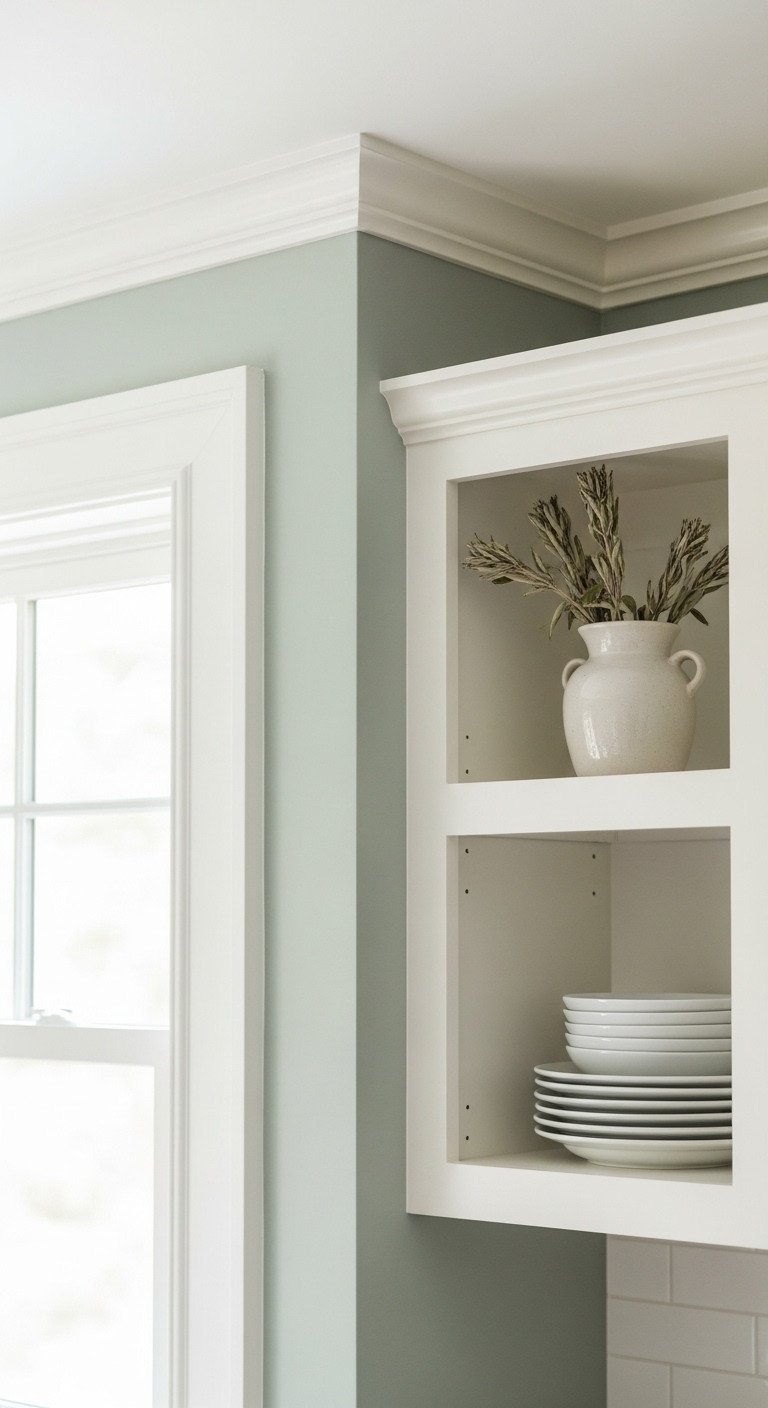
Pin this genius hack to your ‘Dream Kitchen’ board!
A common mistake is pairing earthy sage green with a stark, cool white trim. This creates a jarring contrast that can make the sage look dingy. The expert solution is to always choose a warm, creamy white for all trim and ceilings. Colors like Benjamin Moore White Dove or Sherwin Williams Alabaster have subtle yellow undertones that create a soft, seamless transition, enhancing the warmth of the sage.
Materials Needed:
- Specific Warm White Paint Swatches (e.g., Benjamin Moore White Dove or Sherwin Williams Alabaster)
- Large white foam core boards (for testing large swatches)
- High-quality Painter’s Tape (for crisp lines)
- Trim-specific Primer
- Recommended Product: Durable Semi-Gloss Trim Paint for kitchens (high washability)
Step-by-Step Directions:
- Determine Undertone: Hold your chosen sage green swatch next to a pure white sheet to confirm if the sage has a warm (yellow/brown) or cool (gray/blue) undertone.
- Select Warm White: Choose a white neutral for your trim and ceiling that shares the same underlying warmth (a touch of yellow, not blue or gray).
- Prep and Prime: Clean all existing trim thoroughly, especially near the ceiling line, and apply one coat of specialized trim primer.
- Apply Semi-Gloss: Paint trim using a semi-gloss or satin finish to provide high contrast, durability, and a clean, crisp separation from the flat/eggshell wall color.
Pro-Tip: Interior designers typically use a higher sheen (semi-gloss) on trim than walls (eggshell) for durability and to visually frame the wall color.
2. Define Your Sage Green Undertone (Gray vs. Yellow Base)
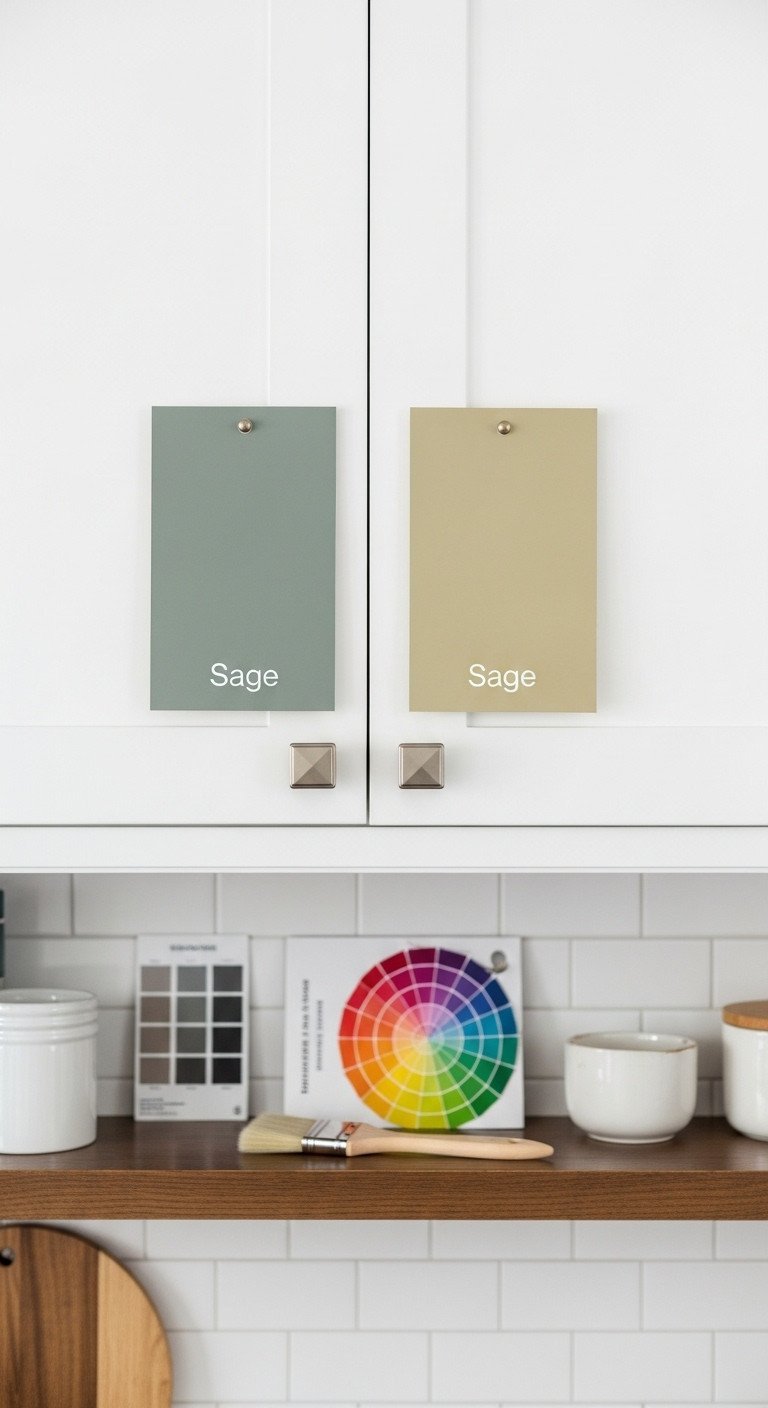
Save this clever organization idea!
Not all sage greens are created equal. Some have a cool, gray or blue base, giving them a more sophisticated, modern feel. Others have a warm, yellow or brown base, making them appear earthier. Identifying this undertone is the single most important step to avoid clashing with your existing kitchen fixtures.
Materials Needed:
- Three different Sage Green Paint Samples (e.g., one gray-based, one yellow-based, one mid-range)
- Large Poster Boards (2ft x 2ft minimum)
- Pure Gray Swatch/Card
- Pure White Swatch/Card
Step-by-Step Directions:
- Test Under Lighting: Paint large swatches on the poster boards and tape them to different walls (North and South facing) in your kitchen.
- Compare Base: Hold the pure gray card next to the sage sample; if the sage starts to pull blue or yellow, you have identified the primary undertone.
- Coordinate Fixtures: If your kitchen has warm elements (oak cabinets, golden granite), choose a sage with a subtle yellow undertone; if your kitchen is cool (marble, stainless steel), choose a gray undertone.
- Observe for 48 Hours: Check the samples at sunrise, mid-day, and night (under artificial light) to ensure the undertone remains pleasing under all conditions.
Pro-Tip: If the color looks too ‘muddy’ or dull, it often means the chosen sage green is too dark (low LRV) for the amount of natural light your kitchen receives.
3. Pair Light Sage Walls with Dark Natural Wood Cabinets

Save this dark cabinet pairing strategy!
If you have dark wood cabinets, like walnut or espresso, you can create a stunning high-contrast look. The key is to use a light sage green on the walls. A lighter shade with a high Light Reflectance Value (LRV) will provide a sharp, clean contrast against the heavy visual weight of the dark wood, preventing the space from feeling too dark or enclosed.
Materials Needed:
- Deep Sage Green Paint (for comparison) and Light Sage Green Paint (for application)
- Accent Hardware (Matte black or Oil-rubbed bronze)
- Reflective Elements (e.g., polished subway tile backsplash)
- Recommended Product: High-Lumen, low Kelvin Recessed LED Lighting (to brighten the dark space)
Step-by-Step Directions:
- Choose Light Sage: Use a light sage green on the walls (LRV 50+) to create a sharp contrast with the heavy dark wood, ensuring visual separation and brightness.
- Keep the Ceiling White: Paint the ceiling pure white or warm white to draw the eye up and prevent the dark cabinets from dominating the room visually.
- Integrate Accents: Use hardware (matte black pulls) or an island base that matches the dark cabinet tone to tie the elements together, using the 60-30-10 rule where dark wood is the 30%.
- Prioritize Reflectivity: Select countertops or backsplashes that are highly reflective (light quartz, polished stone) to bounce light back onto the sage walls, enhancing their color complexity.
Lesson Learned: Dark wood absorbs a lot of light. Using brass hardware instead of black can introduce needed warmth and a metallic reflection against the moody contrast.
4. Utilize the Biophilic Layered Neutral Approach
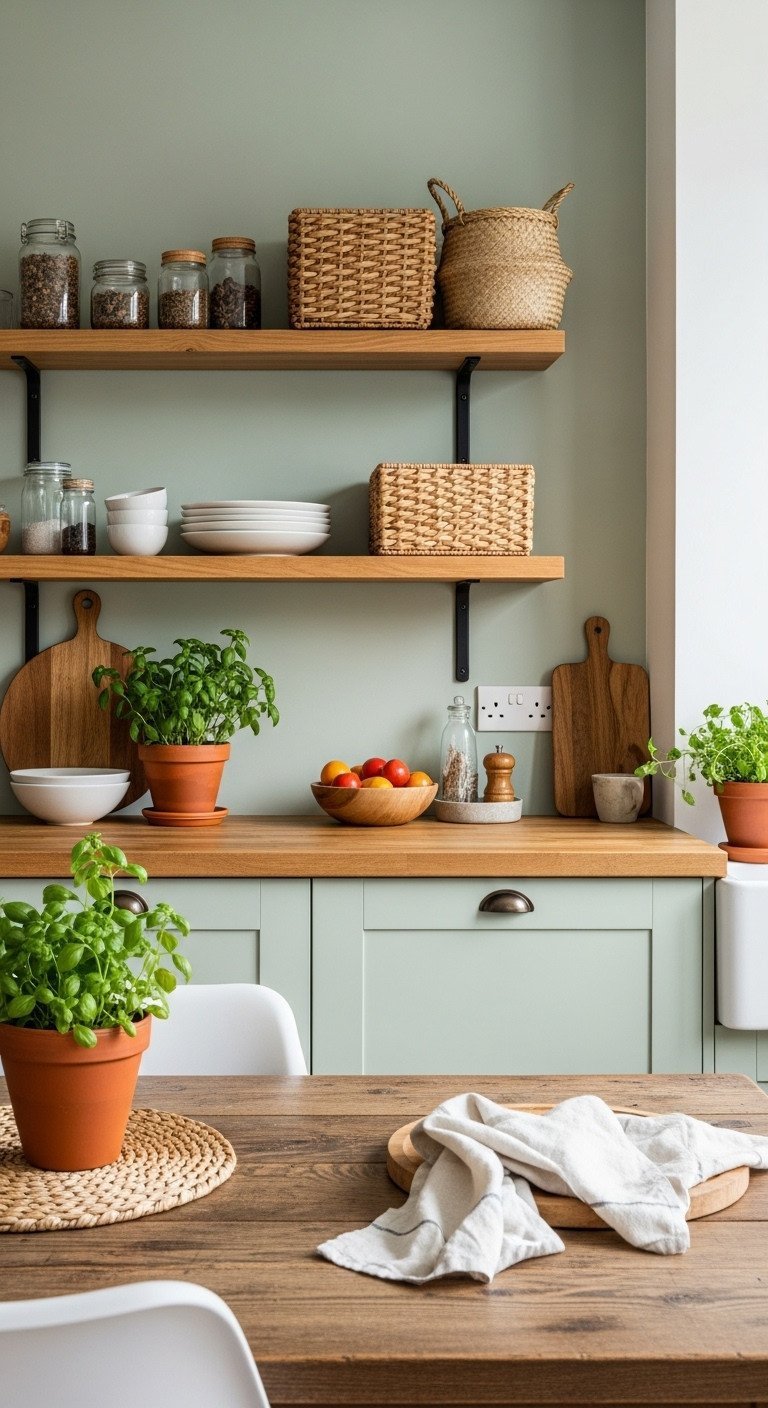
Pin this layered neutral design idea!
To truly enhance the natural, calming aesthetic of sage green, lean into a layered neutral approach. This design methodology uses different textures—rather than different colors—to create depth and interest. Think natural wood, stone, jute, and linen. These organic materials reinforce the biophilic connection of sage green and prevent the space from feeling flat or one-dimensional.
Materials Needed:
- Natural Wood Open Shelving or Cutting Boards (Oak or Walnut for contrast)
- Woven Textures (Jute rugs, linen tea towels, rattan seating)
- Terracotta or Stone Planters (for live herbs/plants)
- Warm-toned LED Under-Cabinet Lighting (to highlight wood grain)
Step-by-Step Directions:
- Introduce Wood: Integrate wood elements via floating shelves, cutting boards displayed openly, or bar stools to reinforce the earthiness of the sage green walls.
- Use Woven Accents: Place small natural fiber rugs or use woven baskets for storage to add a third layer of texture that works seamlessly with the biophilic theme.
- Add Live Greenery: Place small herb plants in the kitchen to connect the sage wall color back to living nature, completing the biophilic circuit.
- Match Lighting Kelvin: Ensure all kitchen lighting is in the warm (2700K-3000K) or neutral (3500K) temperature range to enhance the warmth of the wood and the earthiness of the sage.
Pro-Tip: Sage green works best when paired with natural materials—avoid glossy, synthetic finishes which will visually clash with the color’s organic roots.
5. Apply Eggshell or Satin Sheen for High Durability

Save this essential paint durability tip!
The kitchen is a high-traffic, high-moisture environment, so your paint’s finish (or sheen) is just as important as its color. A matte or flat finish is a mistake for kitchen walls because it absorbs moisture and stains, making it impossible to clean. For sage green walls, the professional standard is an eggshell or a low-lustre satin finish. These sheens provide the durability and scrubbability needed to handle grease and splatters without being overly glossy.
Materials Needed:
- High-quality, Low-VOC Kitchen Paint (Acrylic/Vinyl based formula)
- Scrub Test Kit (if possible, to verify washability)
- Paint Sampler in Eggshell, Satin, and Matte finishes
- Recommended Product: Kitchen-specific paint with high scrub rating (e.g., Benjamin Moore Aura Bath & Spa, Sherwin Williams Duration)
Step-by-Step Directions:
- Exclude Matte: Immediately eliminate flat (matte) finish for kitchen walls, as it cannot withstand scrubbing and will show scuffs and grease stains immediately.
- Compare Sheen Levels: Apply small samples of eggshell and satin sage green paint next to each other to observe light reflection. Satin is slightly more reflective than eggshell.
- Prioritize Washability: Select the eggshell (or low-lustre satin) finish, which provides the scrubbability needed for a kitchen environment without creating a high-shine surface that emphasizes wall imperfections.
- Use Semi-Gloss for Trim: Reserve semi-gloss paint for cabinets, baseboards, and door frames, as this contrast in sheen adds sophistication and maximizes durability where touch traffic is highest.
Lesson Learned: Kitchen environments require paint formulated to resist microbial growth and grease. Always check the VOC level for better indoor air quality, especially in a kitchen.
6. Anchor the Color with Contrasting Matte Black Accents
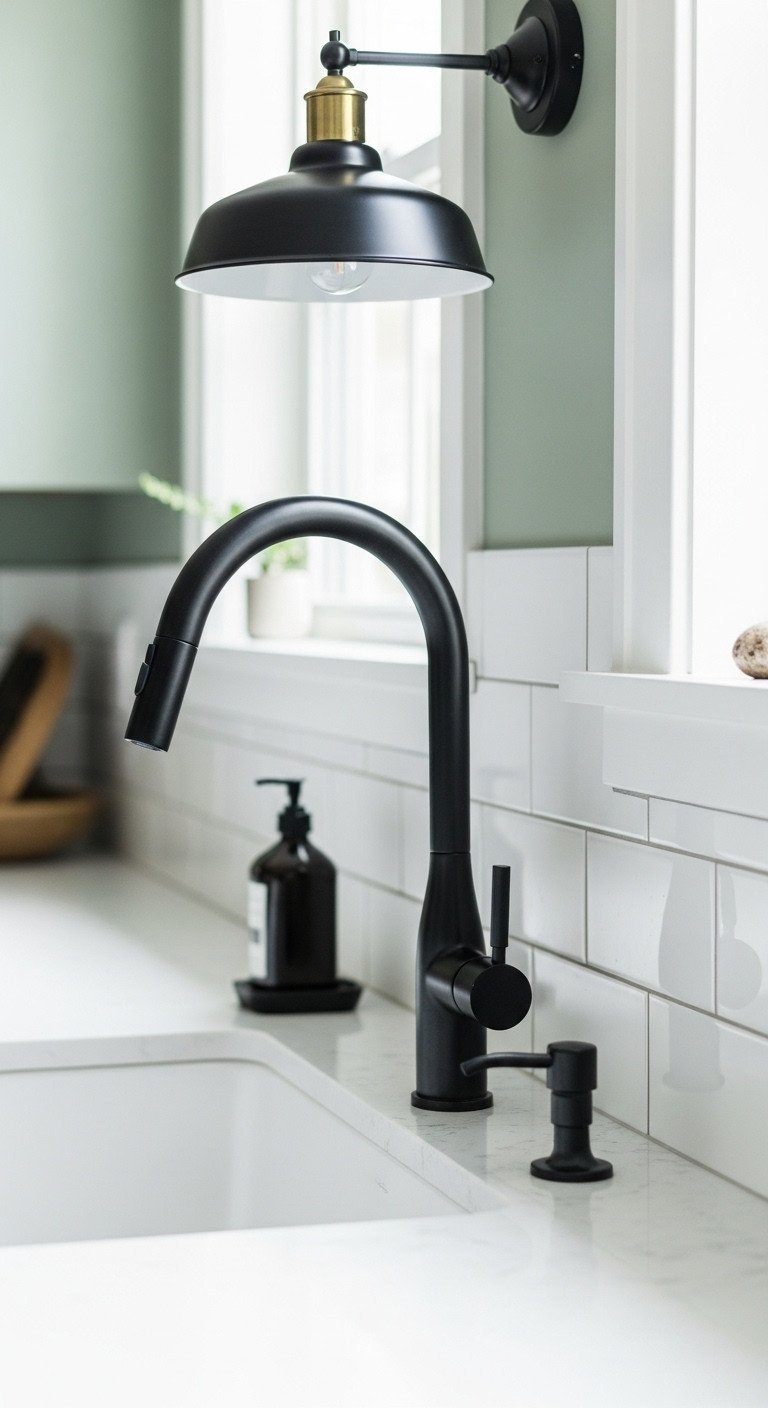
Save this black accent tip for a modern feel!
To give your sage green kitchen a modern, defined look, use matte black accents. The softness of the sage walls can sometimes lack visual weight. Matte black hardware, faucets, and lighting fixtures provide a strong, grounding contrast that anchors the color and adds a touch of sophistication. This high-contrast pairing is perfect for achieving a modern farmhouse or minimalist aesthetic.
Materials Needed:
- Matte Black Cabinet Pulls/Knobs (handles)
- Matte Black Faucet and Soap Dispenser
- Black or Dark Wood Floating Shelves (optional accent)
- Recommended Product: High-quality matte black lighting fixture (pendant or semi-flush mount)
Step-by-Step Directions:
- Commit to Contrast: If your sage green is light, use matte black in at least three places (hardware, faucet, one light fixture) to create clear, defined grounding points.
- Simplify the Lines: Choose hardware with modern, clean lines (like straight bar pulls) to avoid a rustic or overly traditional look, letting the black anchor the design.
- Coordinate Appliances: If using stainless steel appliances, the black fixtures help bridge the gap between the cool steel and the earthy sage, creating a balanced palette.
- Maintain Sheen: Ensure the black accents have a true matte finish rather than a reflective semi-gloss finish for a contemporary, sophisticated appearance against the soft wall sheen.
Pro-Tip: Matte black hardware visually disappears less than brass, providing necessary visual weight to balance the softness of the sage green.
7. Use the 60-30-10 Rule for Perfect Color Balance
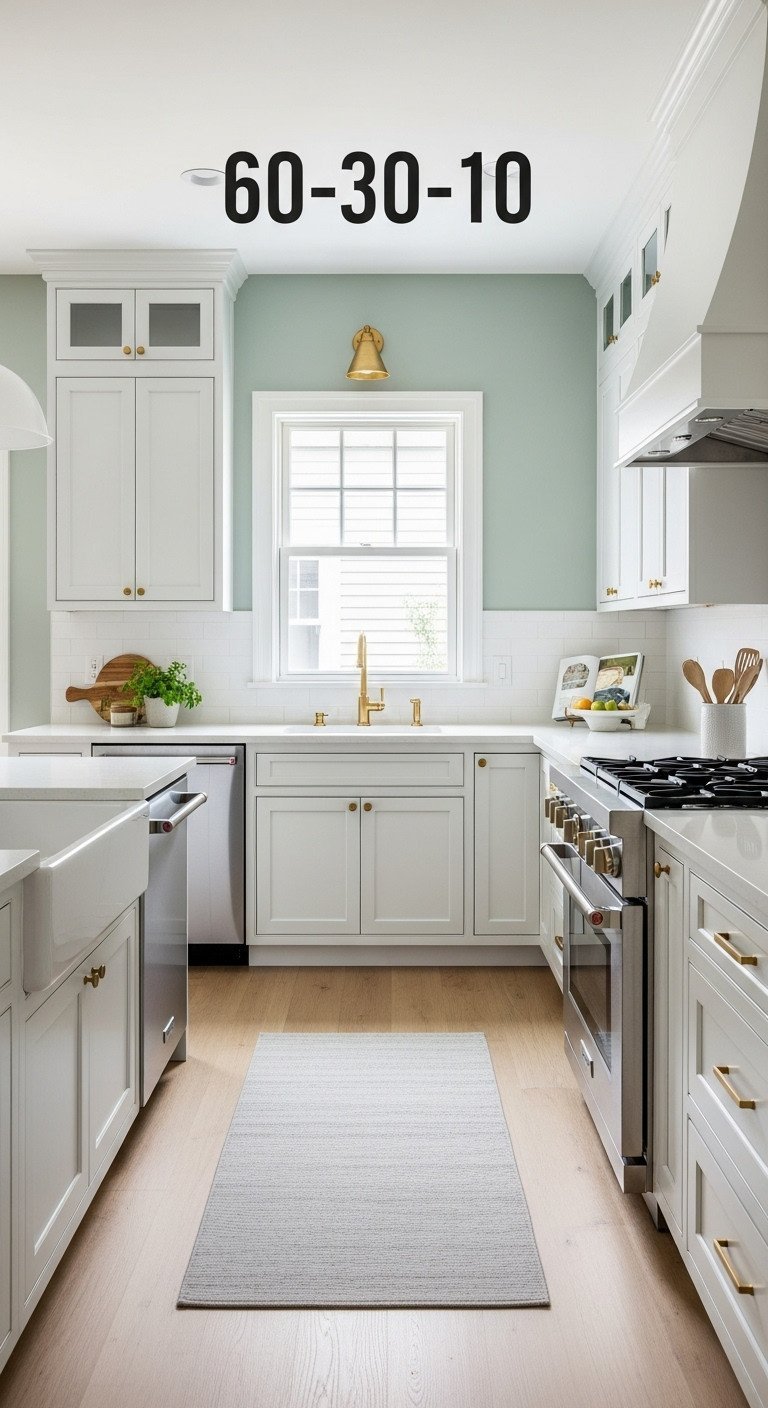
Pin this color theory guide for your renovation!
The 60-30-10 rule is a classic design principle that guarantees a balanced color palette. It prevents any single color from overwhelming the space and creates visual harmony. When your walls are sage green, you’ve already established your dominant color.
Materials Needed:
- Mood Board Template (digital or physical)
- Paint Swatches (Sage Green, Secondary Color, Accent Color)
- Photos of Existing Fixtures (Cabinets, Floors, Countertops)
Step-by-Step Directions:
- Define 60% (The Walls): Designate your sage green wall paint as the 60% dominant color. This color grounds the entire space and sets the mood.
- Define 30% (Cabinets/Floors): Choose your secondary color (cabinets, major upholstery, or flooring) to take up 30%. This should be a neutral like warm white, light gray, or natural wood.
- Define 10% (Accents): Select a contrasting accent color (or metal finish like brass or matte black) for the final 10%, applied through lighting, hardware, and small accessories. This adds the ‘pop.’
- Prioritize Cohesion: Ensure that the 30% (cabinets/flooring) always complements the undertone of the 60% (sage walls) to maintain continuity.
Pro-Tip: Since sage green walls are the 60%, avoid loud or distracting patterns on the 30% elements (like busy granite countertops) to prevent visual overload.
8. Utilize High LRV Light Sage Green in Low-Light Kitchens

Save this clever color trick for small kitchens!
A common concern is that painting walls a color other than white will make a small or dark kitchen feel even smaller. You can safely use sage green by paying close attention to its Light Reflectance Value (LRV). LRV is a scale from 0 (black) to 100 (white) that measures how much light a color reflects. For a small or north-facing kitchen, choose a sage green with an LRV of 50 or higher to ensure the color bounces light around the room, making it feel brighter and more open.
Materials Needed:
- High LRV Sage Green Paint (e.g., Benjamin Moore October Mist, Sherwin Williams Sea Salt)
- LED bulbs with 3500K-4000K Kelvin temperature
- Reflective Accessories (e.g., polished chrome or brass hardware)
Step-by-Step Directions:
- Check LRV: Ensure the sage paint you select has an LRV of 50 or higher; this is the minimum needed to adequately reflect light in smaller or North-facing spaces.
- Keep It Monochromatic: In a small kitchen, use a minimal number of accent colors, allowing the light sage walls and white/light cabinets to dominate the palette for visual expansion.
- Switch Lighting: Replace any yellow-toned incandescent or low Kelvin LED bulbs, which can make sage green look muddy, with neutral to bright white bulbs (3500K-4000K).
- Use Reflective Hardware: Choose polished metal hardware (chrome, polished nickel, or brass) instead of matte finishes, as reflective surfaces will help bounce light back onto the walls.
Lesson Learned: North-facing windows cast a cool, bluish light. Counteract this by choosing a high LRV sage green with a slightly yellow or warm undertone.
9. Plan for Metamerism by Testing Color Under All Lights
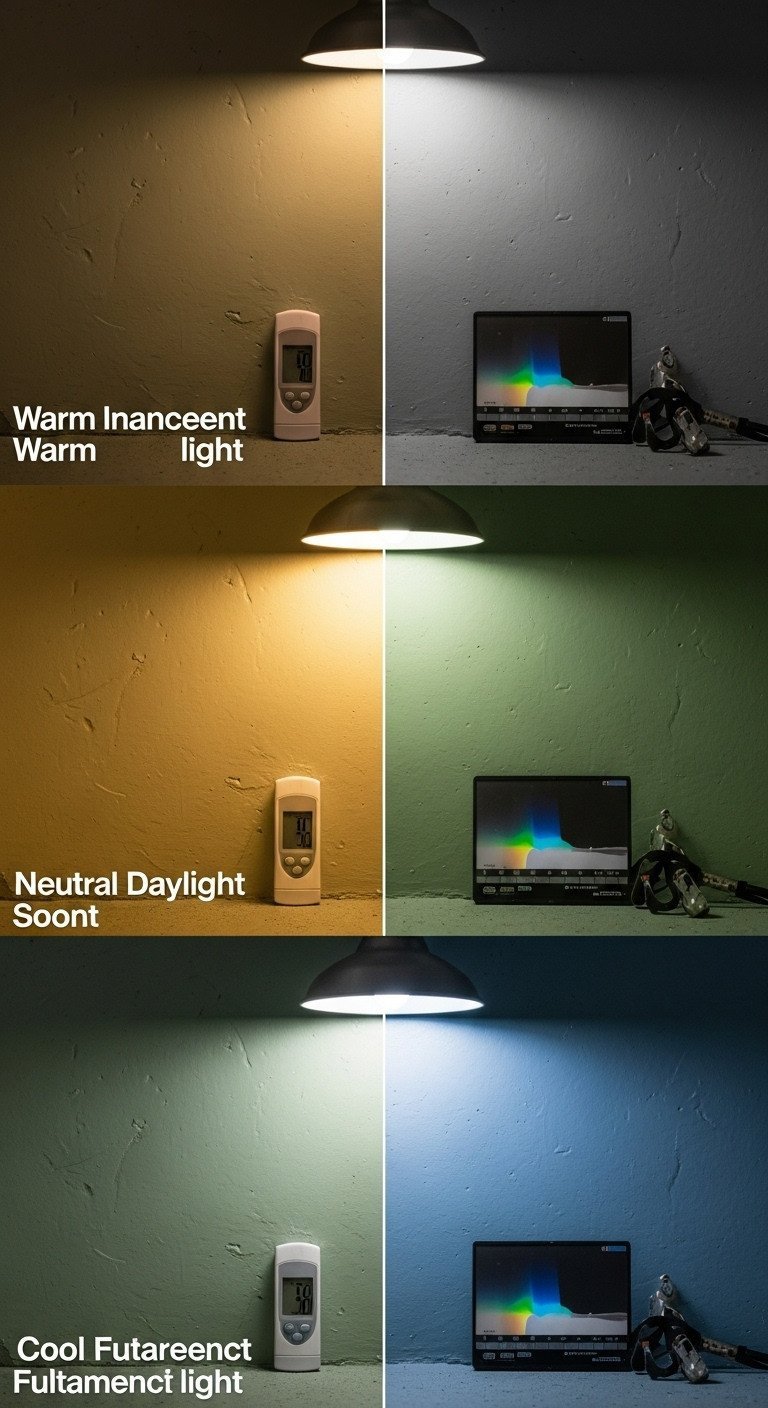
Save this critical lighting principle!
Metamerism is a phenomenon where a color appears to change under different light sources. A sage green that looks perfect in the natural daylight from your window might look muddy and yellow under warm incandescent bulbs at night. This is why testing large paint swatches in your actual kitchen—under all its lighting conditions—is a non-negotiable final step.
Materials Needed:
- Paint Swatches (2ft x 2ft)
- Different Light Bulbs (e.g., 2700K warm, 4000K neutral)
- Recommended Product: Smart lighting system with adjustable Kelvin temperature settings (for full control)
Step-by-Step Directions:
- Test Daytime: Observe your paint swatches primarily during the day, noting how the natural light reveals the true undertone.
- Test Artificial Nighttime: At night, turn on all artificial kitchen lights (recessed, pendants, under-cabinet) and observe the color. If it looks drastically different (e.g., too gray or too yellow), you are seeing metamerism.
- Adjust Kelvin Temperature: If the color is too cool (blue/gray), switch to warmer bulbs (3000K). If the color is too yellow/muddy, switch to cooler, daylight bulbs (4000K).
- Final Check: Ensure the color remains pleasant under both the morning sun and the evening indoor lighting before purchasing the final gallons of paint.
Lesson Learned: Never choose a color based solely on the sample chip you view in a store. The change in light between the store and your home will trigger metamerism.
Key Takeaways: Your Quick Guide to Sage Green Kitchen Walls
Feeling overwhelmed? Here is a quick checklist of the five most important rules to remember for a perfectly balanced sage green kitchen.
- Top 5 Expert Rules Checklist:
- Undertone is King: Always determine if your chosen sage green has a warm (yellow) or cool (gray/blue) base and coordinate all other colors accordingly.
- Choose Warm Neutrals: Pair sage walls with creamy, warm whites (LRV 80+) for trim and ceilings to maintain an inviting atmosphere and avoid sterility.
- Go High-Contrast: Anchor the soft green with high-contrast hardware like matte black or polished brass to add sophistication and definition.
- Mind the Sheen: Select an Eggshell or low-lustre Satin finish for the walls to ensure necessary durability and scrubability in the high-traffic kitchen environment.
- Maximize LRV: If your kitchen is small or dark, choose a light sage green with an LRV of 50 or higher and utilize 3500K-4000K lighting to prevent the color from looking muddy.
People Also Ask About Sage Green Paint
Is sage green going out of style in 2025?
No, sage green is widely considered a timeless classic rather than a trend. Its low saturation and association with nature (biophilic design) position it as a sophisticated, enduring neutral that has successfully transitioned from a trendy color to a foundational design palette, ensuring its longevity well beyond 2025.
What is the best alternative if I find sage green too light?
If sage green feels too light, the best alternative is often a deep olive green or an almost-black forest green. These colors share the same earthy, sophisticated undertones but offer higher saturation and depth, creating a dramatic, jewel-toned kitchen aesthetic without losing the organic feel of the green family.
What color backsplash should I use with sage green walls?
The safest and most popular choice for a backsplash is a classic white subway tile or a very light gray stone. This neutral backdrop ensures the focus remains on the sage green walls and prevents visual clutter. For a warmer look, consider a creamy, textured zellige tile or subtle light wood paneling.
How does sage green look with stainless steel appliances?
Sage green works beautifully with stainless steel appliances. The inherent warmth and earthiness of the sage green walls provide a necessary counterpoint to the cool, crisp tone of stainless steel, creating a clean, balanced, and modern aesthetic. The pairing prevents the steel from feeling too industrial.
Final Thoughts
Embracing sage green walls is a powerful way to inject tranquility and timeless style into your kitchen without the massive commitment of replacing cabinets. By mastering these nine pairing rules—from choosing the correct warm neutral to leveraging the right paint sheen and lighting—you are no longer guessing; you are designing with expert precision. Focus on your undertones and remember that high-quality visual coordination is what turns a trendy color into a long-lasting, inviting home environment.
Which of the 9 rules do you find the most challenging, and what color are your existing cabinets? Share your sage green dilemmas in the comments below
Last update on 2025-11-14 at 23:49 / Affiliate links / Images from Amazon Product Advertising API
